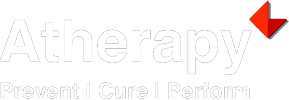Did you know that shoulder pain is the 3rd most common cause of musculoskeletal pain?
Did you know that shoulder pain is the 3rd most common cause of musculoskeletal pain? And that the shoulder is one of the most unstable joints in the body? And that good shoulder function and health relies on optimal movement including that of the collar bone and the shoulder blade. Many muscles contribute to shoulder movement including the shoulder blade setting muscles and the rotator cuff.
Dysfunction of the rotator cuff muscles contribute up to 70% of shoulder disorders and this is something that I see clinically on a weekly basis. Often this can be attributed to a change in exercise frequency or intensity or even having an intense period doing a seemingly innocuous activity such as DIY is enough to cause irritation to the shoulder. Through an assessment it may be possible to highlight whether there is a movement pattern dysfunction, a technique issue or even if it is just a weakness issue.
Often it is a combination of all three of these issues. Obviously it possible to sustain an injury from a traumatic event such as a fall or dislocation, but outside of this these are the three primary categories of causes of shoulder issues that I see. The aim of this blog is to introduce a few different components of your training, or perhaps rehab if you’re currently experiencing symptoms, programme that you may not be doing already.
Tip No.1 – Get Warm
Tip number one is to start your session by warming up with cardio. This may not be practical for everyone if you’re trying to squeeze in a quick 20-30 minute gym session in on your lunch break, but when you have the time start off your session with some cardio. Just 10 minutes of cardio warms the brain up alerting it to the fact you’re exercising. This primes the brain ready to send out motor control signals to the shoulder muscles so when you start your workout routine the muscles are firing like a well oiled machine. (1)
Tip No.2 – Get Specific
Depending on which way your arm moves dictates which muscles work and to what extent. More specifically if you lift your arm forwards (flexion) then the “posterior cuff” (infraspinatus and teres minor muscles) is more active, where as if you move your arm backwards (extension the “anterior cuff” (subscapularis) is more active(2). This is important to know from a rehab point of view if you’re recovering from an injury, but also from a prevention point of view. For example, if you are doing lots of heavy lifting in a flexion position but don’t have good “posterior cuff” strength, motor patterning and endurance, you may well find a lack of control in terms of shoulder movement which can lead to injury over time. Therefore, giving a little bit of thought about the specifics of your exercise programme goes a long way. A side note that the posterior cuff is the muscle group that most often has issues around motor patterning and engaging too. Clinical assessment will help establish if this is the case.
Furthermore, the work by Tardo et al(3) showed different levels of muscle contraction in different positions too. The graph below shows the results of the study involving 14 participants who had muscle activation measured whist performing an external rotation movement with the arm lifted 90 degrees out to the side with 100% support, 50% support and no support at all. This information can help with making exercise selection and help to make specific changes within an exercise to try an bias different muscles.
Tip No.3 – Get down
Your body’s awareness of where it is in space is called proprioception. This means that as you are sat there, engrossed in reading this shoulder health blog looking at the screen of your device, even without looking you are probably very aware of the position that your body is resting in, i.e your knees are bent, head tipped slightly to the left and right elbow bent left arm leaning on the chair. Given the relative lack of stability of the shoulder having good proprioception helps to maintain good shoulder health.
One excellent way to develop this is through including weight bearing exercises in your shoulder routine. Getting ground reaction force loads through the shoulder joint stimulates mechanoreceptors and feeds that proprioceptive input. Weightbearing exercises are also a great way to facilitate muscle activation too, helping to build those neural links between brain and muscles and develop good motor patterns. I like to include exercises involving gym balls and high planks for this.
Tip No.4 – Get on the pull!
To maintain shoulder health you should have an all round well balanced programme encompassing different types of exercises, moving through different ranges specific to what your outcome is. Typically issues occur when these balances get out of sync, and the most common situation is that people spend too much of their time performing push type exercises such as bench press and press ups and not enough time including pulling exercises such as seated or high rows, as they seek those beach body ready pecs. However this can often lead to problems.
To avoid this a general rule is to have a 3:1 pull to push ratio in your routine. What this means is that lets say you are doing 5 x 5 bench press, you would then supplement this with 5 x 5 of standing rows, low rows and wide grip pull ups. Or you might do 5 x 5 bench press then 5 x 10 bent over rows and 5 x 5 standing rows. The idea is that you are doing a 3:1 volume of pull:push. The value in this? Pulling activities provide greater strength gains for the muscles on the back of the shoulder and around the shoulder blade. Weakness of muscles around the back of the shoulder is linked with shoulder issues so its important to keep these muscles strong and functional. In short get pulling!
Tip No.5 – Get broad
As with all movement, muscles do not work in isolation. Any movement requires multiple muscles to work in a variety of ways. Most upper limb movements require good control of the “core”. Whilst this is a fairly ambiguous term, for the purposes of this article the “core” refers to abdominals, gluteals and back muscles. Having well co-ordinated, strong and enduring core muscles will assist with lifting heavier weights and translate into better sporting and functional performance. Whether that’s generating a better tennis serve to tolerating the demands of looking after your allotment. There is some research to indicate that a better performing “core” leads to better should activation. So don’t think about training muscles in isolation, you cant, and start incorporating “core” exercises into your shoulder routines for additional gains.
There we have it, five principles to add to your work out routine to make more gains and build and maintain shoulder health. So remember; get warm, get specific, get down, get on the pull and get broad! You can click here to view the Physio Pro Instagram page for some examples of shoulder exercises to utilise the suggestions made in this blog post.
Happy training
- Mang CS, Brown KE, Neva JL, Snow NJ, Campbell KL, Boyd LA. Promoting Motor Cortical Plasticity with Acute Aerobic Exercise: A Role for Cerebellar Circuits. Neural Plast. 2016;2016:6797928.
- Wattanaprakornkul D, Cathers I, Halaki M, Ginn KA. The rotator cuff muscles have a direction specific recruitment pattern during shoulder flexion and extension exercises. J Sci Med Sport. 2011;14(5):376-82.
- Tardo DT HM, Cathers I & Ginn KA. Rotator cuff muscles perform different functional roles during shoulder external rotation exercises – Tardo – 2013 – Clinical Anatomy – Wiley Online Library. Clinical Anatomy. 2012;26:236-43.

